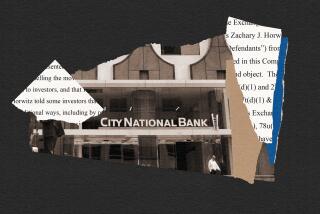Viewpoints : The Latest Junk Bond Scam? : Securities: Wall Street’s newest shell game involves packaging junk bonds. But there’s no pea under the shell--only the potential for big losses for bank, insurance firms and taxpayers.
- Share via
Among the most wondrous Wall Street inventions of the 1980s was the “collateralized mortgage obligation,” or CMO, which is responsible for perhaps $10 billion of the losses suffered by the nation’s S&Ls; on their way down the tubes.
Now, new for the 1990s, we have the “collateralized bond obligation,” or CBO. The CBO is a package of junk bonds that somehow stop looking like junk because they are packaged. It has the potential to create even bigger losses for banks and insurance companies and taxpayers, while generating big profits for Wall Street and its friends in business schools.
The CMO was a kind of bond backed by home mortgages. It paid bondholders with proceeds of homeowners’ monthly payments. The art of marketing it was the division of this payment stream into separate “tranches,” which were sold separately to investors.
The top tranche got first grab at all the money that homeowners paid, and it was very, very safe. After holders of the top tranche were paid, the payments stream went to the second tranche, which was still pretty safe, and so on until it got to a “residual” holder who was entitled to what came in after everybody else got his.
This residual might or might not get paid, depending on lots of factors too complicated to explain not only to readers of a family newspaper but also to the S&L; executives who bought the stuff. Because it was risky paper, it promised big returns--though not, of course, for some years, until after the holders of the senior tranches had been paid off.
Artful Wall Street salesmen persuaded S&Ls; and institutional investors to pay more for the package of tranches in a CMO than they would have paid for the mortgages themselves. Asked why that should be so, Kevin Villani, then chief economist of the Federal Home Loan Mortgage Corp. (Freddie Mac), explained to a meeting of colleagues that “there’s one born every minute.”
The trick was to get S&Ls; to buy the less safe pieces.
The sales pitch carried the fancy name “risk-adjusted arbitrage.” What the name was supposed to mean was that the Wall Street house promised (cross-my-heart) that the S&L; could get a better return on its money while reducing its risks. Michael Lewis’ new best-selling book, “Liar’s Poker,” has 40 funny pages on how this snake oil was peddled by the Wall Street investment firm Salomon Bros. in the mid-1980s.
S&L; regulators, on days when they weren’t out to lunch, tended to take a benign view of this paper. Permitting an S&L; to book income on bonds that wouldn’t actually pay off for some years was an easy way to make it look healthy even though it was sick.
Trading profits on this paper could be recorded as they happened, under S&L; accounting rules. Trading losses could be buried by carrying the stuff on the books at cost. Everything, of course, was bought with money from insured deposits. When riskier tranches turned out to be worthless, and the S&L; failed, taxpayers had to pay off depositors.
Enter the CBO. It packages junk bonds just as the CMO packages mortgages, into tranches. The idea springs from the imagination of Fred Carr, head of First Executive Corp., a Los Angeles-based life insurer. First Executive was one of Michael Milken’s biggest customers. Carr promised purchasers of his insurance policies that the value of those policies would grow quickly based on the high earnings from Milken’s junk bonds.
As the junk bonds have grown riskier, however, state insurance commissioners have wanted First Executive to keep greater financial reserves against the payments that it will have to make on its policies.
Hence the CBO. Carr has converted many of his junk bonds into CBOs, and has kept all the tranches. He argues that a smaller fraction of his assets is in risky paper as a result, simply because the top tranches of his CBOs are safe, having first claim on all payments from the packages of junk bonds. It’s a pure shell game, but the insurance commissioners have kindly allowed First Executive to lop $110 million off its required reserves.
That wasn’t the purpose of this activity, Doug Marcian, executive vice president of First Executive, told the Wall Street Journal. The purpose was just “to create securities that were worth more than the underlying assets.”
It’s hard to imagine a clearer statement of the illusionism that the financial services industry has been staging for investors. Obviously, there is no pea under any of these shells. Asset-backed securities cannot be worth more than the underlying assets. It’s just that the salesmen can sell them for more.
This sort of idea catches on fast.
Thomas Spiegel, who built Columbia Savings & Loan of Beverly Hills, a rival of Carr’s First Executive as Milken’s premiere customer, has resigned from the deteriorating S&L; and plans to work with the Wall Street house of First Boston to repackage Columbia’s nearly $4-billion junk bond portfolio into CBOs that can be sold for more than the assets are worth.
The CBO phenomenon has also spread to the banks, which have begun packaging their leveraged buyout loans into CBOs for sale. A recent CBO made from $675 million of U.S. leveraged buyout loans was sold in London on a basis where the bottom tranche is a zero-coupon bond that will, with luck, yield 20 percentage points a year over the London interbank interest rate. That means the rate is 30% right now.
Zero-coupon bonds pay all the interest they promise in one lump sum at their expiration dates. But holders of such bonds can credit themselves with an interest payment every year. That doesn’t help ordinary people much because ordinary people need cash income. But banks don’t need this cash income, they can always get money simply by promising a higher interest rate on insured deposits. Similarly, life insurance companies are happy with investments that pay off only years from now because they don’t have to pay the benefits until years from now.
Banks want to sell loans these days because new worldwide capital rules require them to put more of their own money (rather than just depositors’ money) into their investments. If they sell off the low-yielding safe parts of the CBO, and keep the high-yielding risky parts, they can credit themselves with more income per dollar of assets. And because their total assets are reduced, they don’t have to put up as much capital to satisfy the new regulations.
Banking regulators are dangerously sympathetic these days to banks that need more high-yielding assets because they have all those losses on loans to Latin America and real estate developers. If we are going to compete with foreigners, our banks have to show good profits, don’t they?
Economist Villani’s analysis of why this magic junk would sell was incomplete. There are really two born every minute: one in the marketplace, and one in the financial services regulatory machinery. Having observed how the S&L; regulators get laughed at these days every time they show their faces in public, maybe the other financial regulators can start taking their responsibilities more seriously. It has been reported that the California insurance commission is re-evaluating its reduction of Carr’s required reserve. That sounds like a good idea.
More to Read
Inside the business of entertainment
The Wide Shot brings you news, analysis and insights on everything from streaming wars to production — and what it all means for the future.
You may occasionally receive promotional content from the Los Angeles Times.










